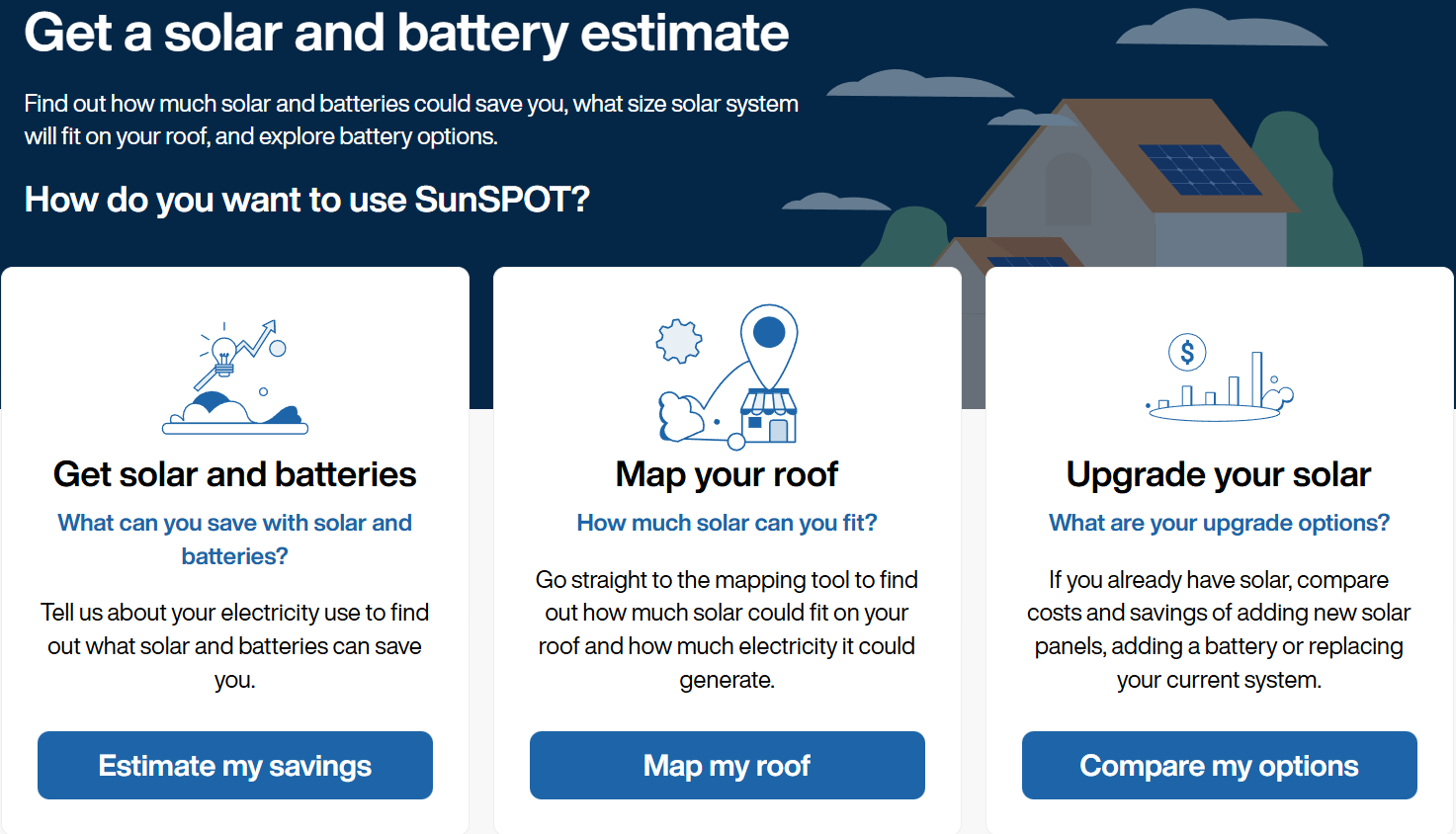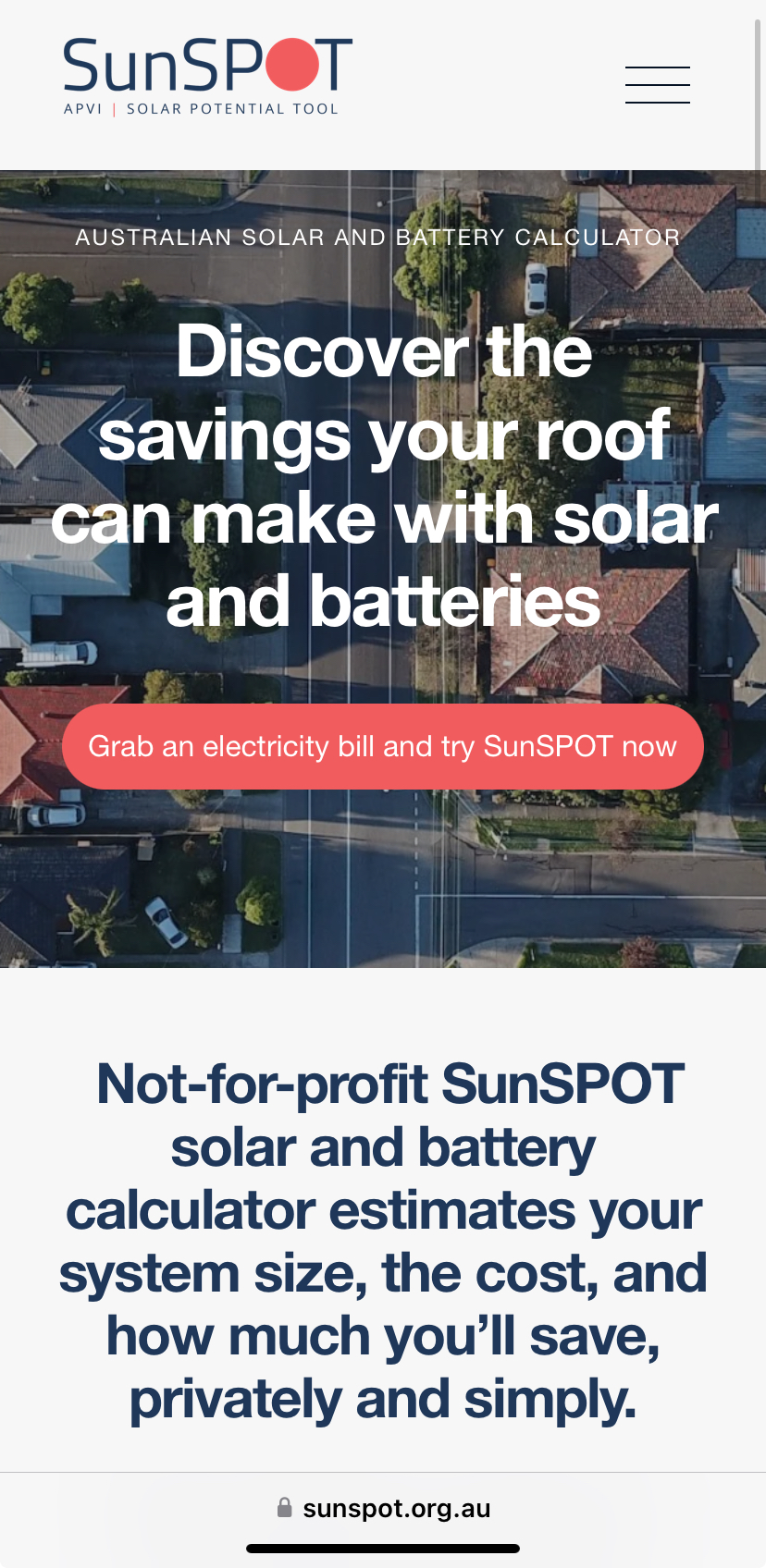

Don’t make any decisions about solar until you’ve tried SunSPOT
Thinking about solar panels or batteries? Before you buy, try SunSPOT, a free, independent solar calculator from UNSW that shows exactly how much solar fits on your roof, how much you’ll save, and how long it’ll take to pay off.
If you’ve ever tried to work out whether solar panels or batteries make sense for your home, you know the feeling, twenty open tabs, a dozen quote sites that want your details, and completely different advice from everyone.
Then I found SunSPOT, a free and independent tool from engineers at UNSW, and it changed the way I think about solar for Australian homes.
Associate Professor Anna Bruce is Deputy Head of School (Equity, Diversity and Inclusion) in the School of Photovoltaic and Renewable Energy Engineering (SPREE) and Joint Director of the Collaboration on Energy and Environmental Markets (CEEM) at UNSW. SunSPOT was Anna’s idea, and she’s been working on it since 2012.

Dr Mike Roberts is a Senior Research Fellow in SPREE, Research Co-Ordinator for CEEM and Project Manager for SunSPOT. Mike’s research aims to address the inter-related technical, economic and social challenges to deploying more renewables and integrating them into the energy system. He arrived at UNSW in 2015 and joined the SunSPOT team in 2019

The problem & why SunSPOT
The truth on solar
If you’ve ever tried to work out whether solar panels or batteries make sense for your home, you know the feeling. Twenty open tabs, a dozen “free” quote sites that only want your details, and completely different advice from everyone. I wanted facts, not a sales pitch. That’s how I found SunSPOT, a tool created by engineers and researchers at UNSW. I spoke with Associate Professor Anna Bruce and Dr Mike Roberts from the School of Photovoltaic and Renewable Energy Engineering. The chat started as a Q and A for this blog, and it genuinely changed how I think about rooftop solar in Australia
Origin story
How SunSPOT started
In 2012 Anna saw the New York City Solar Map and wondered why we didn’t have something similar. Funding from the Australian Solar Institute, now ARENA, kicked off SunSPOT. The first version was a technical research tool, but over time the team saw the biggest impact would come from helping everyday households make informed decisions.
“We realised SunSPOT could have a real impact by directly providing the answers users need to make decisions about solar and battery investments.” Mike said.
What makes it different?
sunspot is different
Most solar calculators fall into two camps. The technical ones are built for installers and assume you speak inverter. The “free” ones simplify everything and usually exist to collect your contact details.
SunSPOT sits in the middle and gets it right. It’s expert-grade but easy to use. You can map panels onto your actual roof, tweak placement and angle, and see how generation, savings and payback change. It’s free, independent and private , no one is trying to sell you panels.
SunSPOT is also backed by public institutions. Trust matters for long-term decisions.- Australian Government, NSW Government, ACT Government, Australian PV Institute, & UNSW.

How SunSPOT works (includes smart-meter flow)
How sunspot works
Behind the clean interface is serious modelling. SunSPOT combines three kinds of data to give you a realistic forecast for your home.
Electricity use data
SunSPOT works best with your real usage pattern. If you have a smart meter, it records your electricity every 15 or 30 minutes and sends that data to your retailer. SunSPOT uses those intervals to see when you actually use power and how solar and a battery will change your bill. No smart meter? SunSPOT asks a few quick questions about your home and appliances and builds a detailed estimate that still works well.
Solar generation data
SunSPOT estimates how much electricity your roof can produce by considering slope, orientation and shading. In many council areas the premium version uses 3D LiDAR mapping to read the exact roof planes and nearby trees or buildings. Where LiDAR isn’t available, SunSPOT uses a simpler roof model. Both are accurate. LiDAR just adds extra precision for complex or shaded roofs.
Costs, savings and payback
You see bill savings and payback based on current tariffs for your network area, real system prices, and the latest government support, including the Cheaper Home Battery program.
Try SunSPOT for yourself
1️⃣ Get solar and batteries
Estimate savings based on your energy use.
Estimate my savings →
2️⃣ Map your roof
See how much solar fits and how much energy it could generate.
Map my roof →
3️⃣ Upgrade your solar
Compare adding panels, a battery, or replacing your old system.
Compare my options →

How to get your smart-meter data from your energy provider
For example, my energy provider is AMBER
Check your bill under Meter Reads. If it says Interval, you have a smart meter.
To use that data in SunSPOT:
• Email hello@amber.com.au and ask for your smart meter interval data in CSV format under the Consumer Data Right.
• Amber will send you a file showing your electricity use every half hour.
• When you’re using SunSPOT, upload that file when prompted, it’ll tailor your results to your home’s actual habits.
Prefer the easy way? SunSPOT’s new Consumer Data Right connection lets you securely authorise a direct data pull from your energy retailer (see below).
No smart meter yet? No worries. SunSPOT will just ask a few quick questions about your home and build a solid estimate from your answers.

Myths + Evolution
One of the biggest myths about solar is that it only works if you have a perfect north-facing roof.
In reality, that’s just not true.
“A lot of systems are installed east or west facing,” Anna said. “That gives you generation when people are actually home, in the mornings and late afternoons, which can make a big difference to your savings.”
SunSPOT helps you see that for yourself. You can play with different panel layouts and directions to find what works best for your lifestyle, not just what looks good on paper. It shows exactly how the timing of your energy use matches up with solar generation, so you can size your system with confidence.
And SunSPOT isn’t standing still. The team continues to evolve the platform to reflect how Australians actually live and use energy. It can analyse existing solar systems, estimate the value of adding a battery, and show how upgrades or extra panels might change your bills and payback period.
“The next big challenge is electrification,” Mike told me. “People are getting off gas and switching to electric heating, hot water and vehicle charging. SunSPOT helps them plan for that future, making sure their solar and battery setup can power an all-electric home.”

Why It Matters
My takeaway
I’ve tried plenty of solar calculators over the years, and most of them left me guessing, or feeling like I was being sold to. SunSPOT is completely different. It’s smart, transparent, and built by researchers who actually care about getting the numbers right.
What I love most is how hands-on it feels. You can literally map panels onto your roof, adjust their slope and orientation, and see in real time how those changes affect your energy generation and savings. The coloured roof dots make it easy to find your sunniest spots, and the interface guides you through testing different system sizes and payback periods. You don’t need to be an engineer, or climb onto your roof with a protractor to get professional-level insights.
That’s why more than 10–15,000 people use SunSPOT every month. The feedback is consistently that it’s easy to use, accurate and, maybe most importantly, independent. People trust it because it’s built by UNSW researchers and backed by government, not sales teams.
And it’s genuinely helping real people make better decisions. Take Jane from Berry in NSW, who used SunSPOT’s Upgrade your solar feature to compare the savings from adding more panels and a battery. Using her own electricity data, she could see exactly which option worked best for her, and avoid unnecessary solar waste in the process.
So whether you’re a homeowner, an architect, a business owner or a council planner, my advice is simple: don’t make any decisions about solar until you’ve tried SunSPOT.
It’s free, independent, and the easiest way to see what solar and batteries can really do for you.
🌞 Try SunSPOT now → sunspot.org.au
🏡 Learn more about my solar solution → theimpossiblehouse.com.au/solutions/solar-for-home
📷 Follow along on Instagram → @theimpossiblehouse
